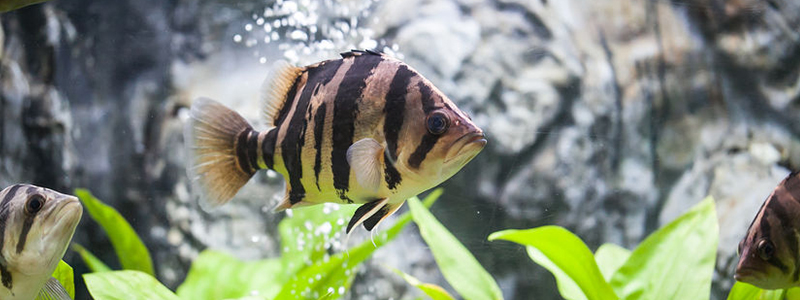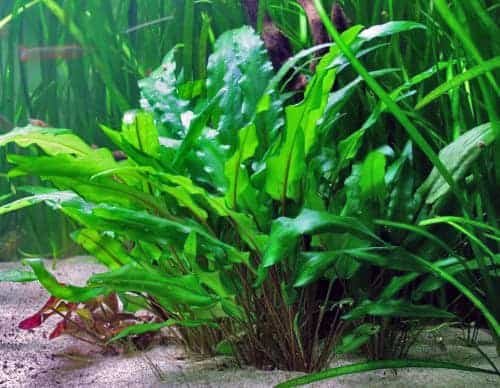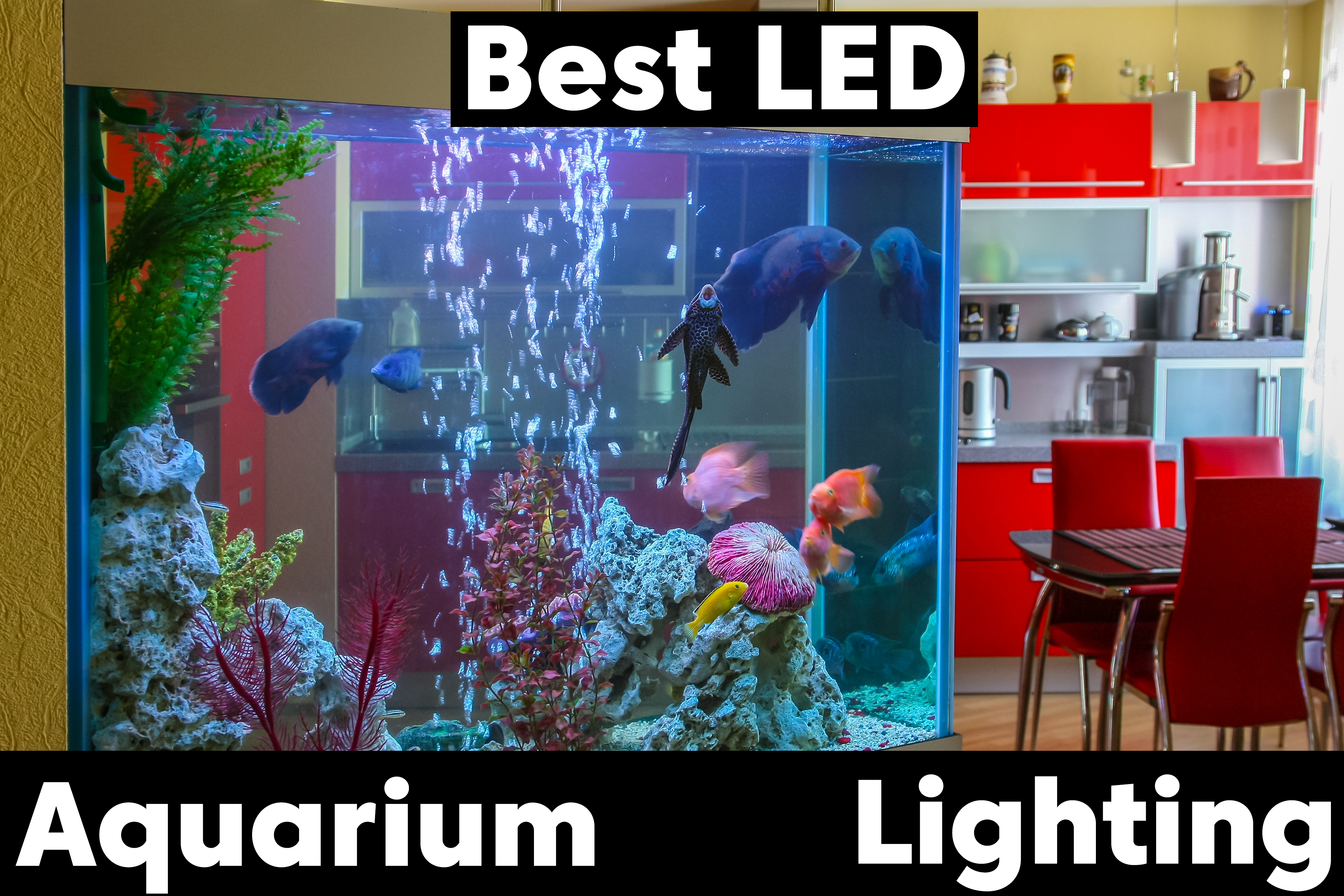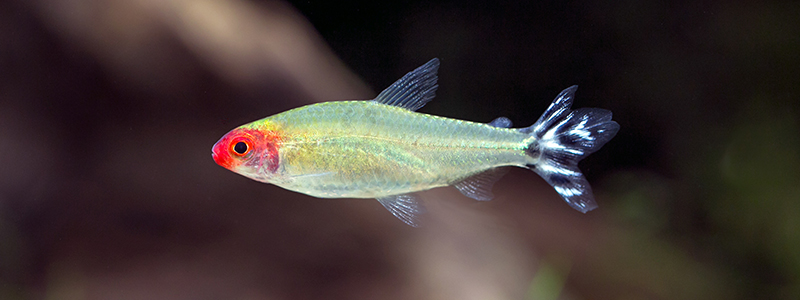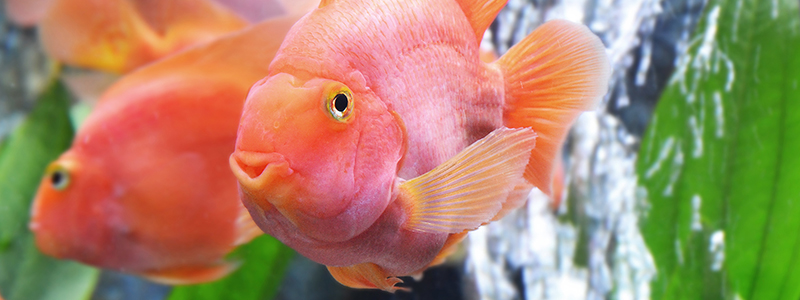Quick Overview
| Attribute | Details |
|---|---|
| Family | Datnioididae |
| Scientific Name | Datnioides microlepis (Indo Datnoid, most common) |
| Common Names | Datnoid, Tiger Fish, Siamese Tigerfish |
| Care Level | Moderate to Difficult |
| Temperament | Semi-aggressive, territorial |
| Max Size | 16–18 inches (40–46 cm) |
| Minimum Tank Size as Adult | 150 gallons |
| Diet | Carnivorous (live/frozen food, pellets) |
| Lifespan | 10–15 years in captivity |
Brief Overview
Also called tiger fish, the datnoid fish is an elegant and majestic fish that makes a fantastic addition to any aquarium. It has a tiger-like pattern on its body and stalks its prey in the same way its aptly-named mammalian counterpart does. There are multiple types of datnoids, but other species of fish are often incorrectly labeled as being datnoids without actually being true datnoids.
There are several types of datnoids, including the Siamese Tiger Fish, the Indonesian Tiger Fish, the Northern Thailand Tiger Fish, the American Tiger Fish, and the New Guinea Tiger Fish. By far, the Indonesian Tiger Fish is the most common type of datnoid owned by aquarium hobbyists. This type of fish offers vibrant coloring, with no visible differences between male and female components of the species.
Datnoid Fish Appearance
Datnoids stand out with their tall, laterally compressed bodies, sharp sloping forehead, and bold black vertical stripes. Their base color ranges from gold to silver, with some species showing reddish tones. Unlike many aquarium fish, datnoids keep their striking coloration throughout most of their lives.
Juveniles (Small Size)
When young, datnoids are only a few inches long but already show their trademark stripes. Juveniles are often more active and sometimes display slightly brighter colors than adults. As they grow, they develop a heavier body shape, and their growth rate is relatively slow compared to other predatory fish. Under proper care, it can take several years for a datnoid to reach a foot in length, and many specimens do not achieve their maximum size until middle age.
Growth Rate
In the aquarium, most datnoids top out between twelve and sixteen inches, although exceptional individuals can grow larger. In the wild, they may exceed eighteen inches, with some reports of specimens approaching two feet in length. Their lifespan in captivity typically ranges from ten to fifteen years, provided they are kept in a properly maintained environment with sufficient space and diet.
Maximum Size
Lifespan: 10–15 years in captivity with proper care.
In the wild: up to 24 inches (60 cm).
In aquariums: more commonly 12–16 inches (30–40 cm).
Types of Datnoids

Datnoids are a common choice for aquarium owners for their resplendent looks and tiger-like stripes on the body. However, based on the origin and features, Datnoids can be broadly categorized as given below:
Siamese Tiger Fish or Wide Bar Datnoid:
These are the most common varieties of Datnoids. Most people confuse Siamese Tigers with the Indonesian Tigers as they look almost the same. Siamese Tiger Fish have three main stripes on the body and two uneven stripes at the tail fin.
Indonesian Tiger Fish or Indonesian Datnoid:
To a novice, Indonesian Tigers are not easily distinguishable from Siamese Tigers. The only difference is that, unlike Siamese Tigers, Indonesian Tiger Fishes will have three or four stripes on the body and two identical stripes on the tail fin. The two stripes on the tail are exactly the same size.
Northern Thailand Tiger Fish or Thin Bar Datnoid:
This species is found in the riverways of Northern Thailand and is famous for the broad straight stripes on its body. Also, the bright golden hue can be yellowish at times.
American Tiger Fish or Silver Tiger:
Silver Tigers got their names from the silver-tone on their body.
New Guinea Tiger Fish or New Guinea Datnoid:
This variety is mostly found in the freshwaters of New Guinea islands. They are easy to identify with the wavy pattern of gold and black on their body.
Datnoid Fish Care: Diet & Feeding
What do datnoids eat in the wild?
In the wild, datnoids are opportunistic predators that feed primarily on live foods. Their diet includes worms, insects, small fish, crustaceans, and even shrimp or crabs when available. While they may occasionally attempt to eat larger fish, they generally target prey that is smaller or similar in size to their own mouth capacity. This instinctive preference for live prey can make them a little challenging to feed in captivity, especially when first introduced to the aquarium.
Feeding habits
Feed your datnoid fish about once or twice a day. Never feed more than the fish can eat in one feeding. While wild-caught datnoid fish will be hard to train to eat commercial fish foods, it is easy to train young fish to eat a number of commercial foods, like pellets, meaty sticks, krill, or silversides. You can also feed them live foods like feeder shrimp, fish, or bloodworms.
What foods are recommended for datnoids?
Datnoid fish prefer to eat live food, but this of course can be a challenge to a home aquarium hobbyist. Over time, you can teach your datnoid to accept pellets and frozen food. Commercial food or frozen foods may also be fed. That being said, due to their wild instincts, they will much prefer live foods and this can be a challenge to acclimate them to your tank at first.
| Food Category | Best Options | Why It Works |
|---|---|---|
| Pellets | Hikari Massivore Delight, NorthFin Carnivore, Omega One Super Carnivore Sticks | Balanced nutrition, easy to feed, trains fish off live foods |
| Frozen Foods | Shrimp, krill, silversides, smelt, bloodworms | Mimics wild diet, adds variety |
| Live Foods | Ghost shrimp, small feeders, earthworms (occasional only) | Stimulates hunting instinct but should not be staple |
Among these, Hikari Massivore Delight is one of the most reliable pellet foods for large predatory fish like datnoids. It offers dense nutrition in sinking form and is readily accepted by many once they are transitioned away from live prey. Pairing this with frozen shrimp or krill a few times per week will give your datnoid a balanced, long-term feeding plan.
Datnoid Fish Tank Setup
Brief overview of natural habitat: Datnoids are native to the rivers and brackish waterways of Southeast Asia, particularly in Thailand, Indonesia, and the Malay Peninsula. In their natural environment, they are found in vegetated areas with submerged trees, roots, and murky water where their bold stripes provide excellent camouflage. This ability to blend into their surroundings allows them to ambush prey while also avoiding larger predators. Replicating aspects of this environment in the aquarium is essential for keeping datnoids comfortable and stress-free.
These fish are naturally found in vegetated areas with plenty of submerged trees and routes. They are often heavily camouflaged, using their striped patterning to allow them to hide as they wait for prey.
Datnoid Tank Size (and why this much space is needed)
A large aquarium is non-negotiable when keeping datnoids. Adults require a minimum of 150 gallons, and larger tanks are strongly recommended if you plan to keep multiple specimens or large tank mates. Juveniles can be housed temporarily in a 60-gallon tank, but they will quickly outgrow it, and upgrading to a more spacious aquarium is a must.
These fish need both open swimming space and plenty of hiding places, as their natural behavior is to alternate between patrolling and retreating into cover. Because they are strong jumpers, a tight-fitting lid is necessary. A powerful external canister filter is also recommended, as datnoids are heavy feeders and produce significant waste.
Datnoid Water Conditions
Water quality is especially important for this species. Datnoids thrive in slightly acidic to neutral water, with a pH between 7.0 and 7.5 and temperatures ranging from 75 to 80°F. They are highly sensitive to poor water conditions and elevated nitrates, which makes regular water changes essential. Moderate water flow is ideal, replicating the gentle currents of their native rivers.
| Parameter | Recommended Range |
|---|---|
| Temperature | 75–80°F (24–27°C) |
| pH | 7.0–7.5 |
| Hardness | Soft to Moderate |
| Tank Size | 150 gallons+ (adult) |
Decorations
Decorating the tank to mimic their natural environment helps reduce stress. Provide driftwood, rocks, and live plants with long leaves or grassy growth patterns. These create natural hiding spots where the fish can retreat when startled or while stalking prey.
Lighting should be diffused rather than harsh, and shadows from driftwood or plants will make the datnoid feel more secure.
Datnoid Tank Mates
General Behavior of Datnoids
Datnoids are not only beautiful, but they can also become very domesticated. Since you can keep them for up to ten years (their average lifespan in captivity), your datnoid will grow used to your presence and actually become somewhat tame. Many aquarium hobbyists actually report being able to feed their datnoid fish from their hands.
That being said, datnoids are usually very shy when they are first placed in a new environment. As they become more acclimated, they will warm up and will not hide quite as frequently. Young datnoids tend to be much shyer than their older companions and will hide frequently behind plants and rocks.
Datnoid Tank Mates

Datnoids are striking fish not only because of their appearance but also for the bond they can form with their keepers. With lifespans that often reach ten years or more in captivity, many aquarists report that their datnoids grow accustomed to human presence, sometimes even taking food directly from their hands. Despite this, they are naturally cautious and shy, especially when first introduced to a new aquarium. Juveniles in particular will spend much of their time hiding among plants, rocks, or driftwood until they feel secure. Over time, they generally become more confident and spend longer periods in the open.
When it comes to tank mates, datnoids are best kept with caution. They are ambush predators by instinct, using their camouflage to stalk and inhale smaller fish in a single strike. For this reason, any fish small enough to fit in their mouth is at risk of being eaten. While they are not typically aggressive toward fish they cannot swallow, they may show territorial behavior toward newcomers until they settle in.
The safest companions are other large, semi-aggressive fish that can hold their own without posing a direct threat. Many hobbyists keep datnoids alongside species like bichirs, large catfish, arowanas, or peacock bass. Datnoids can also be kept with their own kind, and in fact, they often display more natural behavior when kept in groups. An even number—such as four or six—is recommended to prevent one individual from being singled out.
| Suitable Tank Mates | Notes |
|---|---|
| Dinosaur Bichir | Bottom-dwelling, hardy, and similarly sized |
| Large Catfish (e.g., Synodontis, Redtail) | Datnoid must be big enough to not be swallowed |
| Peacock Bass | Active predators that match their size and temperament |
| Arowanas | Surface swimmers, but require very large tanks |
| Group of Datnoids | Work best in groups of four to six |
Smaller community fish, cichlids of modest size, and invertebrates such as shrimp or snails should be avoided, as they will almost certainly be treated as prey. By choosing companions carefully and providing enough tank space, datnoids can coexist peacefully with other impressive aquarium species.
How to Keep Datnoid Fish Healthy
Datnoids are generally hardy fish, but they are sensitive to stress and poor water conditions. One of the most common signs of stress is a noticeable darkening of their coloration; a normally golden datnoid may turn blackish when it feels threatened or unhealthy. This stress response is often linked to overcrowding, poor water quality, or sudden changes in environment. Providing a spacious aquarium, maintaining excellent filtration, and keeping water parameters stable are the best ways to prevent illness.
While datnoids are resilient, they can still suffer from common aquarium diseases. The most frequent issue is ich, which appears as small white spots on the body and fins. Infected fish may also clamp their fins or scratch against objects. Ich is treatable with standard aquarium medications and by quarantining affected fish. Fin rot is another potential problem, usually caused by bacterial infections that take advantage of damaged tissue in dirty water. In rare cases, datnoids may also develop eye problems such as cloudy eyes or protruding eyes, often related to vitamin deficiencies or bacterial infection.
| Condition | Symptoms | Treatment |
|---|---|---|
| Ich | White spots, clamped fins | Quarantine + ich medication |
| Fin/Tail Rot | Ragged or decaying fins | Antibiotics (tetracycline, chloramphenicol) + improved water quality |
| Eye Issues | Cloudy or protruding eyes | Vitamin A supplementation or antibiotics (penicillin, amoxicillin) |
The best way to keep datnoids healthy is through prevention. Maintain high water quality with a powerful canister filter, and perform frequent water changes to control nitrates. Since datnoids produce a large amount of waste relative to their size, good filtration is essential. Overfeeding should also be avoided, as excess food quickly degrades water quality. When feeding live foods, make sure they are quarantined beforehand to avoid introducing parasites or pathogens into the aquarium.
A well-maintained tank not only prevents disease but also reduces stress. With stable water parameters, adequate space, and a proper diet, most datnoids live long, healthy lives without major health concerns.
Breeding Datnoids
Breeding datnoids in captivity is considered virtually impossible. To date, there are no reliable reports of successful breeding in home aquariums, and even large public aquariums struggle to reproduce them. Most datnoids available in the aquarium trade are wild-caught, which contributes to their higher price and limited availability.
Interesting facts
Datnoids are known for their occasional hunger strikes, during which they may refuse food for days or even weeks. While this behavior can be worrying, it is not uncommon among predatory fish. One method aquarists use to overcome this is adding other fast-eating species, such as large barbs or Giant Danios, to the tank. Watching other fish eat often encourages the datnoid to resume feeding.
Is a Datnoid Fish Right For You?
Datnoids are a favorite among hobbyists who enjoy keeping large predatory fish. They are more expensive than many other aquarium species, and their size and dietary needs make them best suited for experienced aquarists.
However, once settled, they are hardy, long-lived fish that reward their owners with striking coloration and fascinating behavior. With proper tank size, compatible companions, and a consistent feeding routine, a datnoid can thrive for well over a decade, making it a worthwhile addition for those prepared to meet its needs.
Frequently Asked Questions
How big do datnoid fish get?
Most datnoids in aquariums grow to 12–16 inches, while wild specimens may reach over 18 inches.
How long do datnoids live?
With proper care, datnoids usually live 10–15 years in captivity.
Are datnoid fish aggressive?
Datnoids are predatory but not typically aggressive toward fish they cannot eat. They may show territorial behavior at first but settle once acclimated.
Can datnoids live with other fish?
Yes, they can be housed with other large species like bichirs, arowanas, catfish, or even groups of their own kind. Smaller fish should be avoided.
What do datnoid fish eat?
In the wild they eat small fish, shrimp, and insects. In aquariums, they thrive on a mix of frozen foods like shrimp and krill along with high-quality carnivore pellets.
How often should I feed a datnoid?
Juveniles should be fed two to three times daily, while adults do best with one feeding per day or every other day.
Can datnoid fish be bred in captivity?
Breeding datnoids in home aquariums is considered nearly impossible. Most available in the hobby are wild-caught.

